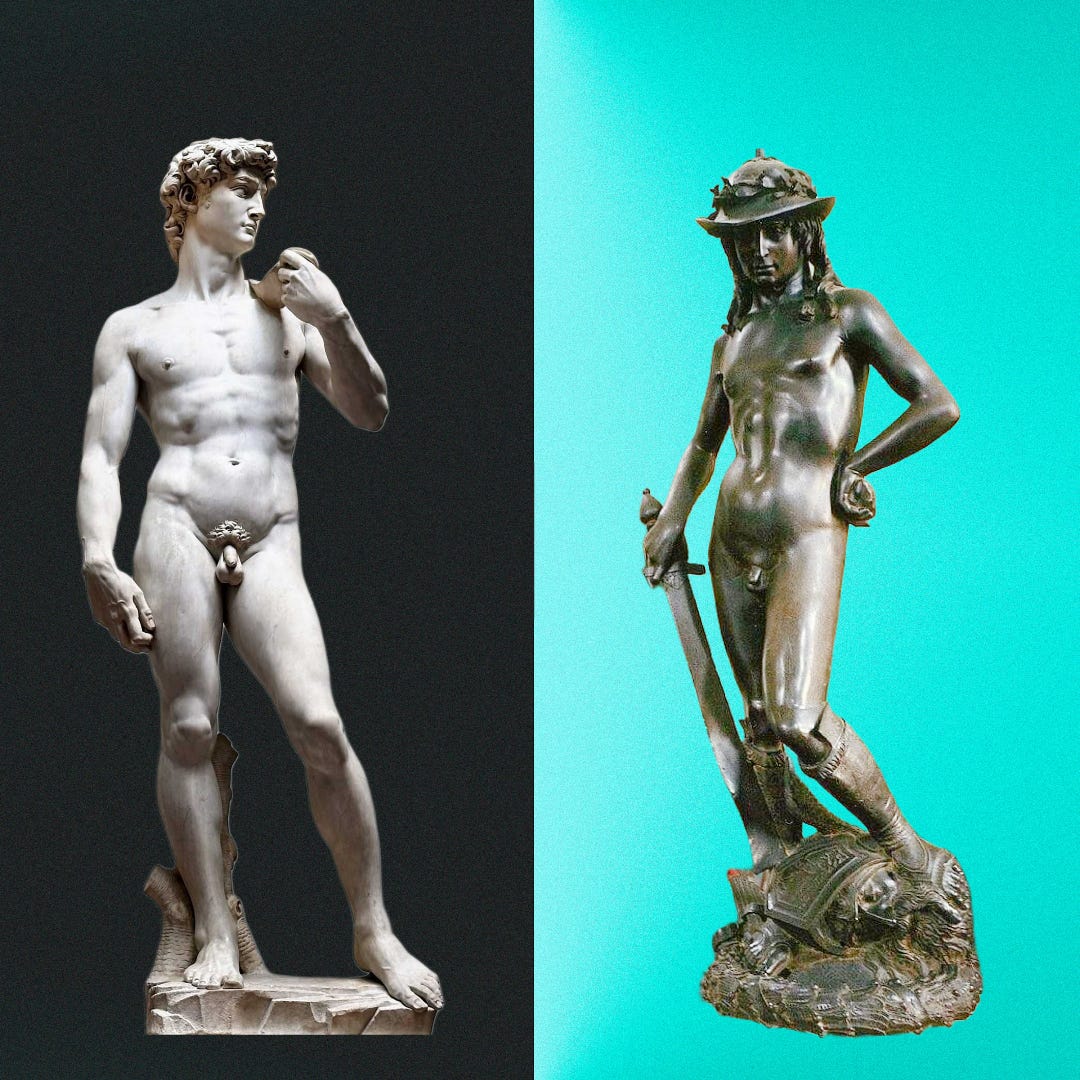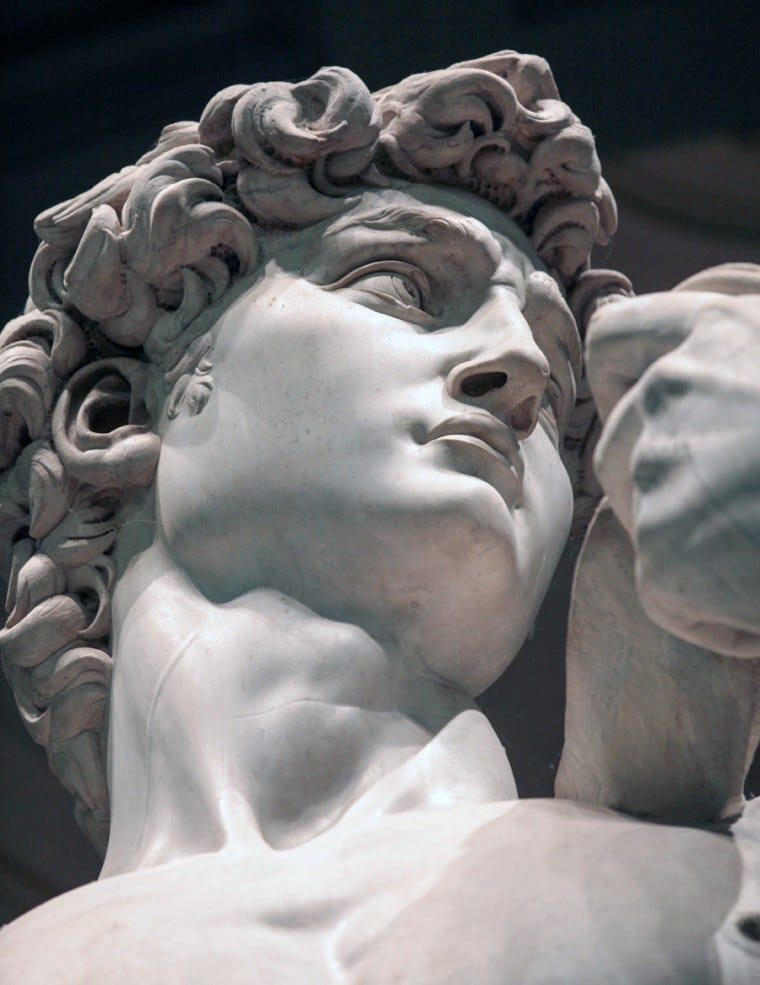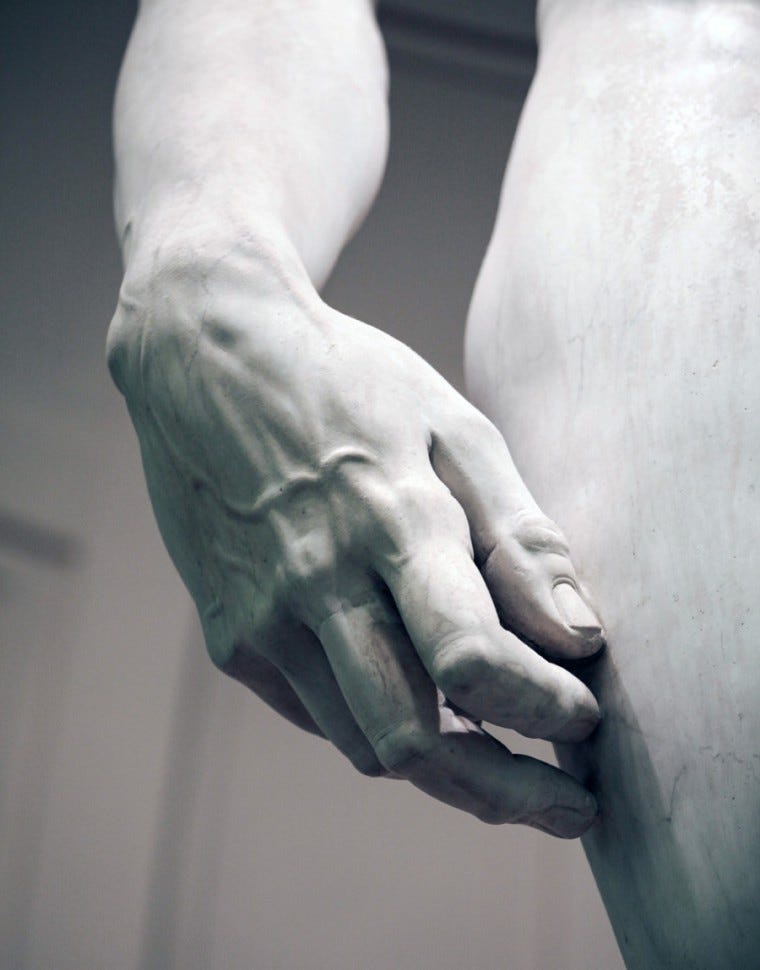After forty days of challenges, Saul began growing antsy. The Philistine giant and monster of a man, Goliath, had demanded that Saul, the king of Israel, send a warrior to fight him. Goliath taunted, saying that the loser’s nation would become the winner’s subjects. A young shepherd boy stepped forward with only a sling, a small stone, and unwavering faith. As the strength of God fills his meager body, David releases the sling and hits the giant directly in the head, killing him instantly.
The story of David and Goliath holds particular importance to the city of Florence. The city has always been a thriving cultural center, yet it has historically had to face off against higher powers trying to capture the city for themselves: the Papacy in Rome, powerful families, the Duke of Milan, etc. The small city-state finds strength in the defiant underdog of David, which is why two beautiful interpretations of the young boy are held within its walls.
Michelangelo’s “David” (1501-1504)
Michelangelo’s “David” is, without argument, one of the most famous works of art ever made. I have always found it fascinating that a statue portraying a frequently depicted Bible story can become significant to so many different groups of people. The story of David and Goliath stands as an introduction to many as an underdog; it inspires those who feel weak compared to the “giant” they are facing. However, many other “Davids” have been sculpted by many other artists. But Michelangelo’s work withstands the test of time: why?
Michelangelo’s artistic style is renowned for exaggerated musculature and often distorted proportions. One of the most acclaimed examples of this stylistic choice is his “Pietà.” Sitting at the entrance of St. Peter’s Basilica, in a chapel sharing its name, sits this masterpiece of Catholic sculpture. The “Pietà” evokes a level of melancholy that other depictions of the Mother Mary mourning her son do not. This is because of Michelangelo’s emblematic usage of sculpted fabric to represent the weight of Jesus’s death on Mary, and also due to Mary’s wildly disproportionate body allowing for a fully grown Jesus to lie comfortably in his mother’s lap, as if returned to that scene in the manger when their lives first intertwined.
David’s extremely detailed right hand is disproportionately large in comparison to the rest of his body. Of course, this was no mistake on the part of the master of human anatomy. David’s biblical nickname is “manu fortis,” which translates to “strong hand” because of the power he received from God to win against a much more physically powerful foe. The detail and enlargement of this hand emphasize the importance of the power of God over earthly strength.
Another subtly important aspect of this statue is David’s relaxed contrapposto: a stance where most of the weight rests on one leg. This stance is exemplary of Renaissance humanism, which emphasizes the beauty, structure, and uniqueness of the human body. Michelangelo was a pioneer in this style of art, and this is why every aspect of the body of his David points to the battle he is about to face: his gaze is focused, his pose is defiant, and he is both relaxed and prepared for battle.
Michelangelo’s “David” can be dissected endlessly, as it is a sculptural masterpiece. However, I have always seen a difference between the tall, imposing masculinity of Michelangelo’s “David” and the overzealous, scrawny David of the Bible. Michelangelo created a symbolic figure of Florentine resistance standing at an impressive twenty feet and sculpted from pure, perfect Carrara marble. The sculpture's strikingly bold features and confident stance serve as a powerful emblem of defiance, stability, and strength, resonating not just within Florence but throughout the entire art community. However, David was not only courageous and devout; he was also young and clever.
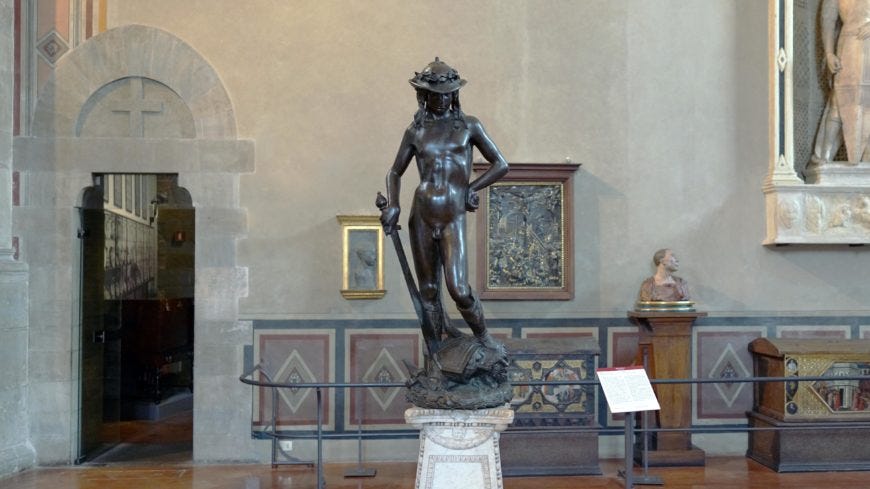
Donatello’s “David” (1430-1440)
Donatello’s “David” provides a stark contrast to the large, looming glare and intense musculature of Michelangelo’s “David.” Donatello created the intricate, bronze statue of a young, celebratory David for the Medici family as an interpretation of the symbol of Florence's civic identity. This statue was the first free-standing nude created since antiquity, which was nearly a thousand years prior, making it a remarkable feat in early Renaissance sculpture.
It was in my high school art history class when I first saw the slightly grainy, cheap projector quality photos of Donatello’s ”David.” The innumerable divergences between these two beautiful interpretations stunned me; if you were to place both of these pubescent teenagers next to each other, Donatello’s “David” wouldn’t even reach the height of the pedestal Michelangelo’s is fixed on. Each detail of Donatello’s “David” pointed to the fact that the unlikely hero was, very clearly, unlikely. I have always been drawn to how markedly Donatello underscores David’s age, making him a symbol for average people with a heart full of irrational morality, a group I have often identified with.
The statue stands at a short, but realistic, five feet two inches, depicting a cheeky stance from the young hero. This David is clearly a young boy, as his muscles are undefined and his body is unremarkable; he has a feminine face and long, curly hair, which is set under a laurel-decorated shepherd’s hat, emphasizing him as a symbol for the common people. His leg is posed atop Goliath’s decapitated head in a relaxed manner as he looks down in disdain with one hand on his hip and the other holding Goliath’s comically large sword.
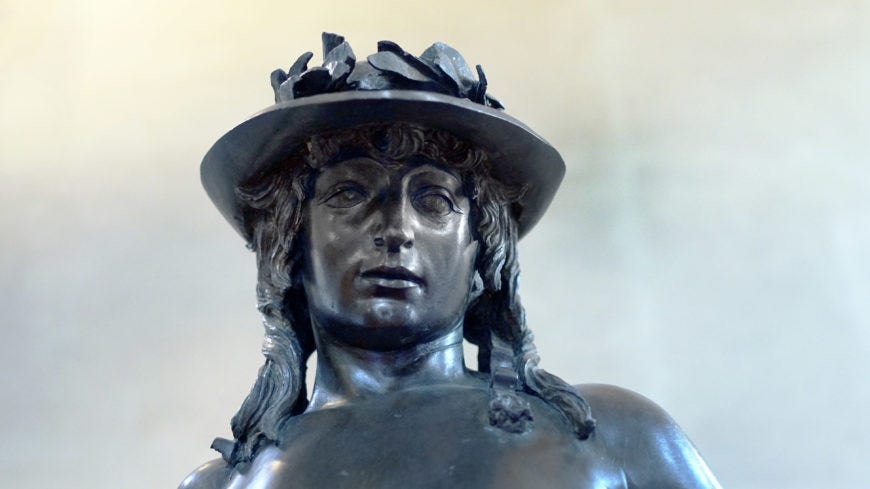
Donatello emphasizes the internal strength of David through his nonchalant, witty, and prideful pose. He is small and androgynous, unlike most depictions of male heroic figures, and his delicately composed nudity reflects the innocent morality and spiritual purity of this underdog story. His depiction of the hero focuses on the simple beauty of a brave shepherd boy, causing the viewer’s mind to wonder how this symbol of elegance could have brutally murdered a monster. This pose humanizes David in a juxtaposition to Michelangelo’s interpretation, as Donatello connected this biblical story to humble people while Michelangelo created an emblem of Florentine strength and resilience.
Both interpretations of this biblical hero highlight the cultural significance David has to the history of Florence, and it is fascinating to see how similar two very different-looking statues can be. Michelangelo and Donatello desired to illustrate the humanity in David’s fight against Goliath. They emphasize David’s reliance on faith and morality, two key virtues representative of Florence’s fight for freedom from powers that ignore the will of the people. People who can see themselves in young David.



